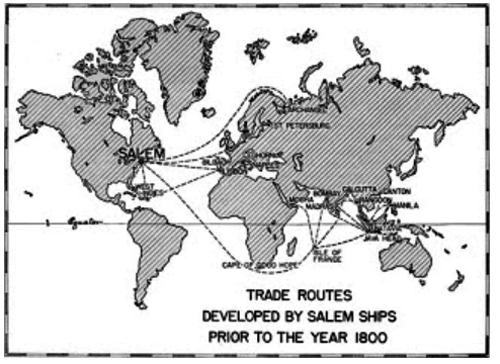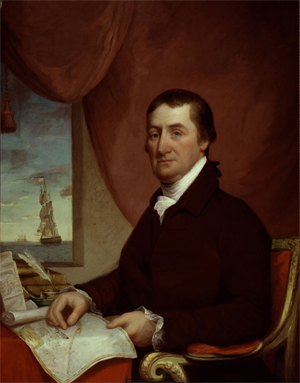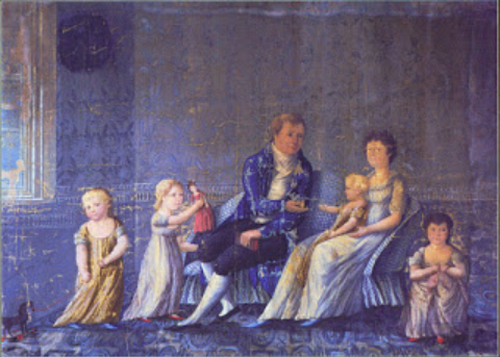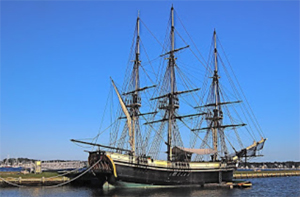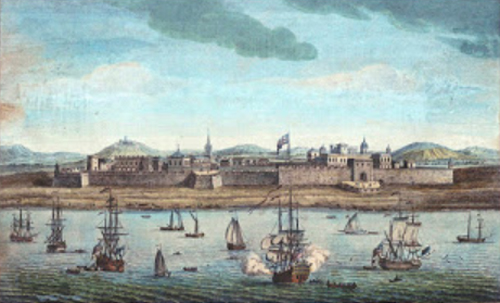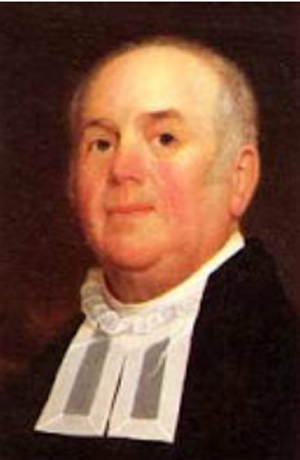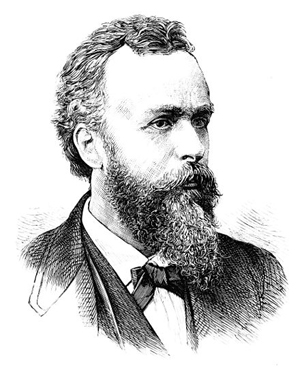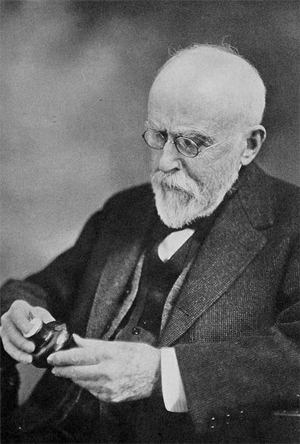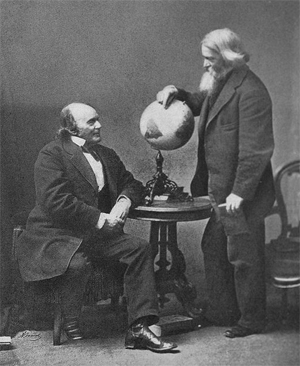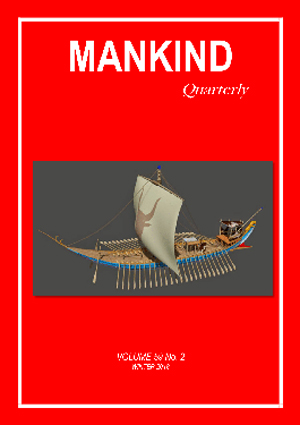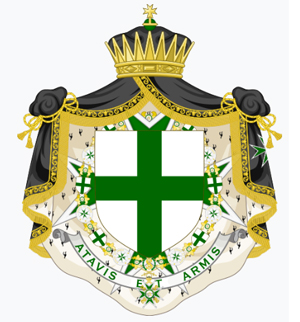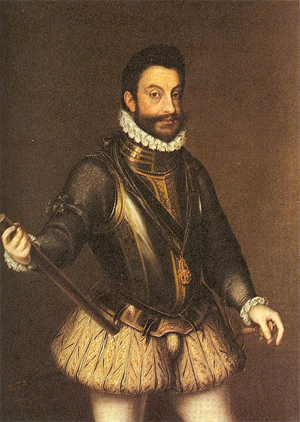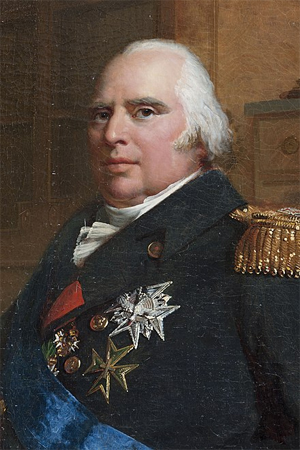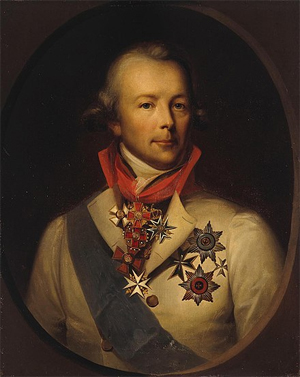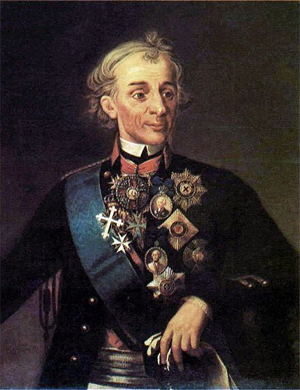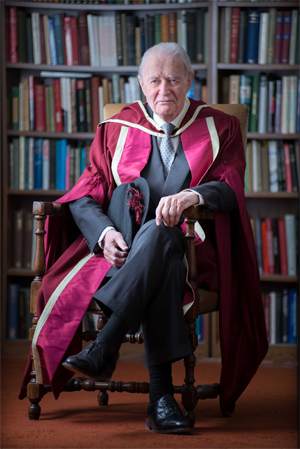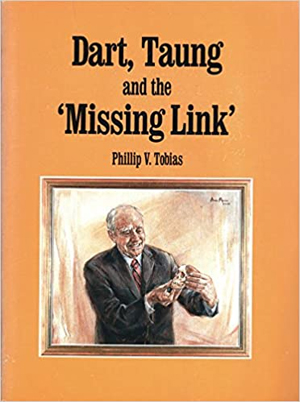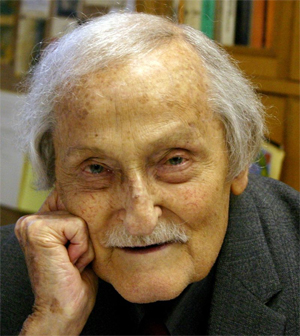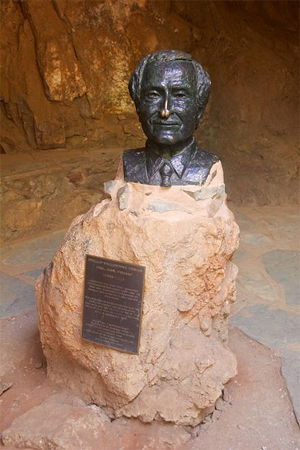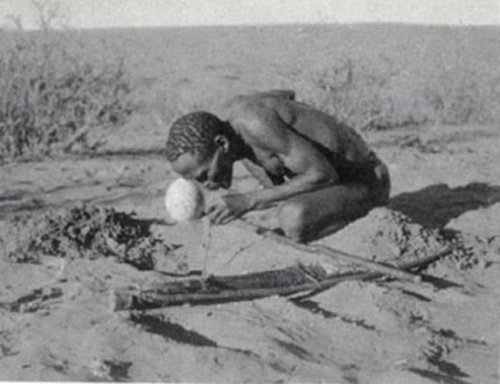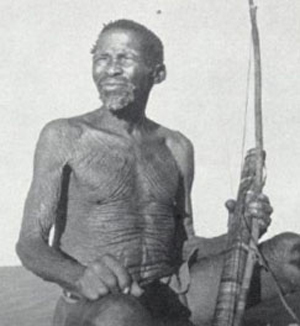Re: Freda Bedi Cont'd (#2)
Peabody Essex Museum
by Wikipedia
Accessed: 6/25/20
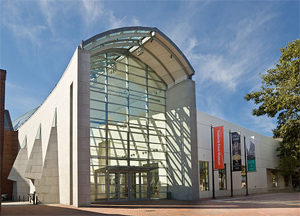
Peabody Essex Museum
The main entrance to the museum
Peabody Essex Museum is located in MassachusettsPeabody Essex Museum
Established: 1799
Location: 161 Essex Street, Salem, MA 01970
Type: Art museum
Accreditation: AAM, NARM
Director: Brian Kennedy
Public transit access: Newburyport/Rockport Line; Salem Station Handicapped/disabled access
Website pem.org
The Peabody Essex Museum (PEM) in Salem, Massachusetts, US, is a successor to the East India Marine Society, established in 1799.[1] It combines the collections of the former Peabody Museum of Salem (which acquired the Society's collection) and the Essex Institute.[2][3] PEM is the oldest continuously operating museum in the United States [4] and holds one of the major collections of Asian art in the United States. Its total holdings include about 1.3 million pieces, as well as twenty-two historic buildings.[5]
The Peabody Essex ranks among the top 20 art museums in the United States by measures including gallery space and endowment. Once the Advancement Campaign is complete and the newly expanded museum opens in 2019, PEM will rank in the top 10 North American art museums in terms of gallery square footage, operating budget and endowment. The PEM holds more than 840,000 works of historical and cultural art covering maritime, American, Asian, Oceanic and African art, Asian export art and two large libraries with over 400,000 books and manuscripts.[6]
History
In 1992, the Peabody Museum of Salem merged with the Essex Institute to form the Peabody Essex Museum.[5] Included in the merger was the legacy of the East India Marine Society, established in 1799 by a group of Salem-based captains and supercargoes. Members of the Society were required by the society's charter to collect "natural and artificial curiosities" from beyond the Cape of Good Hope or Cape Horn. They were also required to personally circumnavigate the globe, and share navigational discoveries with other Society members, thereby increasing their chances of returning from their voyages safely. Due to the institution's age, the items they donated to the collections are significant for their rare combination of age and provenance. The East India Marine Society built East India Marine Hall, a National Historic Landmark now embedded in the museum's facilities, in the 1820s to house its collection. This collection was acquired by the Peabody Academy of Science (later renamed the Peabody Museum of Salem) in 1867, along with the building, which continued to serve as a museum space through these mergers and acquisitions.
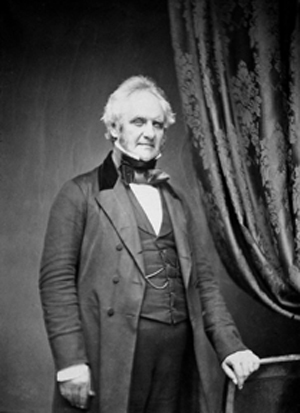
George Peabody, benefactor
2000s–2010s
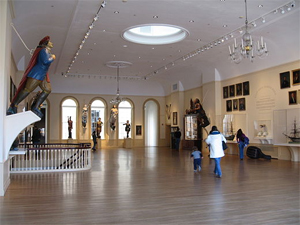
The East India Marine Hall is one of the oldest parts of the museum, built in 1825. The space is used for special events, and for temporary art installations
In 2003, the museum completed a massive $100 million renovation and expansion resulting in the Peabody Essex Museum opening a new wing designed by Moshe Safdie, more than doubling the gallery space to 250,000 square feet (23,000 m²); this allowed the display of many items from its extensive holdings, which had previously been unknown to the public due to lack of exhibition space. At this time, the museum also opened to the public the Yin Yu Tang House, an early 19th-century Chinese house from Anhui Province that had been disassembled in its original village and reconstructed in Salem.[5]
In 2011, the Peabody Essex Museum announced it had raised $550 million, with plans to raise an additional $100 million by 2016.[7] The Boston Globe reported this was the largest capital campaign in the museum's history, vaulting the Peabody Essex into the top tier of major art museums.[8] The PEM trustee co-chairs Sam Byrne and Sean Healey with board president Robert Shapiro led the campaign.[9]$200 to $250 million will fund the museum’s 175,000-square-foot (16,300 m2) expansion bringing the total square footage to 425,000 square feet (39,500 m2).[10]
In May 2012, the PEM confirmed that its expansion will not be finished until 2019, due to the unexpected death of museum architect Rick Mather in April 2012 and the search for his replacement. The firm of Ennead Architects was chosen after successfully completing the first phase of the building project, which included master planning and the renovation of the museum's Dodge wing, scheduled to open in November 2013. [11][12]
On September 28, 2019 the museum opened a new 40,000-square-foot wing, designed by Ennead Architects of New York, adjacent to East India Marine Hall. This addition included 15,000 square feet of Class A galleries as well as a 5,000-square-foot-garden designed by Nelson Byrd Woltz Landscape Architects. [13][14]
Leadership
The museum was led by Dan Monroe, the Rose-Marie and Eijk van Otterloo Director and CEO from 1993 until his retirement in 2019.[15][16] He was succeeded on July 15, 2019 by Brian Kennedy, who previously directed the Toledo Museum of Art.[17][18] Kennedy has served as assistant director of the National Gallery of Ireland, director of the National Gallery of Australia, and director of the Hood Museum of Art at Dartmouth College. Kennedy has an abiding interest in perception and visual literacy and is deeply committed to arts education. [19]
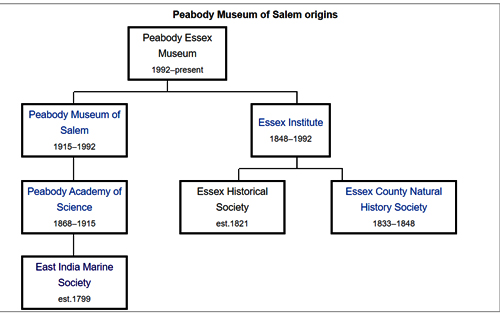
Peabody Museum of Salem origins
Collections
African Art
The Peabody Essex Museum's collection of African art includes approximately 3,600 objects as of 2014. [20] The acquisition of these works began in the early 19th century, as members of the East India Marine Society collected objects from West and sub-Saharan Africa. These objects include ceremonial masks, pottery, woven baskets, and a significant collection of Ethiopian art—particularly Christian icons and metalwork, many of which are based in the traditions of Byzantine art.[21] In 1812, Salem became the headquarters of the American Board of Commissioners for Foreign Missions, which went on to establish missions throughout the continent. These missions facilitated trade, particularly with the Zulu in South Africa, and contributed significantly to the growth of the collection.[22]
American Art
PEM's extensive collection of American art includes over 1,000 portraits,[23] among them works by John Singer Sargent, Fitz Henry Lane, and James Bard. Furniture, folk art, and needlework are also prominent features of the collection. The museum's New England heritage has brought it an especially large array of decorative arts from the Northeastern United States. Many of these objects were initially collected by the Essex Institute, which was dedicated to preserving the cultural and physical history of Essex County.[24]
Chinese Art
The museum's collection of Chinese art, which includes over 6,000 objects[25], features contemporary and ancient works as well as works by minority nationalities within China.[26] Ceramics, textiles, and calligraphy form the bulk of the collection, which began in the 18th century with exports acquired by New England traders. Even before the founding of the East India Marine Society, missionaries such as Reverend William Bentley were collecting sculptures, fans, and other pieces that would form the foundation of the museum's collection.[27] The largest piece at the museum is the Yin Yu Tang House, a late 18th century home from the Anhui province of China. This house, constructed during the Qing Dynasty, was acquired by Nancy Berliner, at the time PEM's curator of Chinese art and culture, before being taken apart and reassembled in Salem.[28]
Indian Art
The Peabody Essex Museum's collection of Indian art includes over 5,000 objects.[29] It also possesses numerous works of Tibetan and Nepalese origins, along with perhaps the most important collection of contemporary Indian art outside of India.[30] PEM's Herwitz Gallery, opened in 2003 and named to honor art collectors Chester and Davida Herwitz, is the first American museum gallery dedicated to modern Indian art.[31] PEM's collection spans a wide array of eras and mediums, forming a detailed record of India's artistic transformations during colonial rule and its aftermath. As PEM's ex-curator of South Asia and Korean Art Susan S. Bean observed, "the global development of industrial production brought machine-woven textiles, printed images, and photography into competition with handlooms, sculpture, and painting," all of which are art forms well represented throughout PEM's collection.[32]
Japanese Art
Featuring approximately 18,300 objects,[33] PEM's collection of Japanese art began with the museum's inception in 1799. Its collections of work from the Edo Period and Meiji Period are particularly robust, featuring armor, sculpture, painted scrolls, furniture, and more.[34] Much of the collection has its origins in the travels of Edward S. Morse, the third director of the museum, who acquired many pieces over the course of three trips to Japan. Morse also helped raise interest in Japanese art in Massachusetts and New England: as Midori Oka states, Morse was "instrumental in influencing the area intellectuals and connoisseurs to turn their interests to Japanese art."[35]
Korean Art
The Peabody Essex Museum has approximately 1,800 pieces of Korean art in its collection, including ceramics, textiles, and painted screens. The collection began in 1883, as the result of a collaboration between museum director Edward Sylvester Morse and Korean scholar Yu Kil-chun, who was a member of the first official Korean delegation to the United States.[36] Much of the collection consists of art of the Joseon Dynasty, which occupied the transitional period between the traditional Korean empire and modernity.[37] Many of the pieces in the collection, particularly those from the Joseon period, display the centrality of art in the habits, rituals, and ceremonies of everyday Korean life. As former PEM curator Susan S. Bean observes, art objects were "essential to the conduct of social life because they conveyed values, fulfilled wishes, provided access to deities and ancestors, taught lessons and conferred prestige."[38]
Maritime Art
By the end of the 18th century, coinciding with the museum's 1799 founding, Salem was one of the nation's most prosperous seaports, and extensive trading of furs, spices, dyes, and other goods brought much wealth to the region.[39] This long legacy of trade contributed greatly to the foundation and growth of PEM's maritime art collection, which is among the finest of its kind in the country.[40] The collection includes over 50,000 objects, including paintings, model ships, scrimshaw, and more. Many diverse styles and periods of maritime art are on display in the collection, from navigational tools such as sextants to modern marine art, which addresses "nostalgic themes" and represents "the seafaring life of previous times."[41] One significant feature of the currently installed collection is a recreation of a room in Cleopatra's Barge, an opulent yacht which was built by Salem's Crowninshield family and eventually became the royal yacht of King Kamehameha II.
Native American Art
PEM's collection of Native American art includes over 20,000 objects,[42] spanning a wide variety of tribal affiliations and time periods. The collection includes masks, textiles, jewelry, clothing, sculpture, and more, along with many pieces by contemporary Native American artists such as Frank Day and Kay WalkingStick.[43] The origins of PEM's collection can be traced to even before the museum's 1799 founding: the maritime fur trade, as well as the trading of iron to local tribes, made the exchange of art objects a frequent occurrence. As Richard Conn writes, "in some cases, objects of considerable importance were given by their native owners as gifts to their European trading partners. The intent here was probably to enhance the trading relationship and to insure that the Yankee or British ship would return next year with more iron."[44]
Oceanic Art
Featuring objects from over 36 different groups of islands in Polynesia, Melanesia, and Micronesia, the Peabody Essex Museum's collection of Oceanic art contains over 15,000 objects in total.[45] These objects, consisting of sculptures, weapons, clothing, and more, include pieces made from traditional Oceanic materials such as porpoise teeth, abalone, and human hair. Also worth noting is the museum's particularly substantial collection of Hawaiian art, which includes over 5,000 objects.[46] While Salem had little direct trade with Hawaii during the 18th and 19th centuries, regional trade and donations from prominent sea captains led to the acquisition of many significant pieces, including some associated with Kamehameha I and James Cook.[47]
Photography
PEM's collection of photography is its largest single collection by number of objects, featuring over 850,000 images.[48] The collection began in 1840, just one year after the invention of photography. It includes work by pioneering photographers such as William Henry Fox Talbot and Antoine Claudet. It also features a collection of rare Civil War photographs by Matthew Brady, one of the first American photographers. The collection has a vast variety of subjects and styles, from records of native life in the Philippines to photographs by Walker Evans which document the Great Depression.[49]
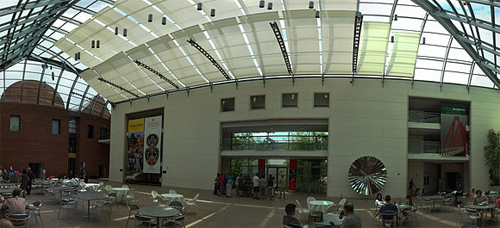
The spacious central atrium has movable solar shades – (July 2013)
The museum presently owns collections of maritime art, including works by marine artist James Bard.[50] The museum also has collections of rare books, manuscripts and ephemera (in the Phillips Library); photography (a collection comprising more than a half million rare and vintage images). On December 8, 2017, much to the dismay of Salem residents, Dan L. Monroe, PEM’s Rose-Marie and Eijk van Otterloo Director and CEO, issued a press release announcing that the 42,000 linear feet of historical documents will be permanently relocated to Rowley, Massachusetts and Plummer Hall and Daland House, the two historic buildings which had housed the Phillips Library, will be utilized as office and meeting space.[51]
Architecture in the collection
The museum owns 24 historic structures and gardens, some of which are concentrated in the old Essex Institute grounds which now form the Essex Institute Historic District. 5 of these buildings are National Historic Landmarks and 8 others are listed on the National Register of Historic Places. Some are shown in the gallery below. The full set of buildings are: Daniel Bray House, Gilbert Chadwick House, Cotting-Smith Assembly House, Crowninshield-Bentley House, John Tucker Daland House, Derby-Beebe Summer House, East India Marine Hall (integrated into the main museum), Gardner-Pingree House and Gardner-Pingree Carriage House, Lyle-Tapley Shoe Shop, Dodge Wing of the Peabody Essex Museum, Asian Export Art Wing of the Peabody Essex Museum, Peirce-Nichols House, Samuel Pickman House, Plummer Hall, Quaker Meeting House, L. H. Rogers Building, Ropes Mansion, Andrew Safford House, Summer School Building, Vilate Young (Kinsman) House, and John Ward House.[5] Some of these properties are open to guided tours.
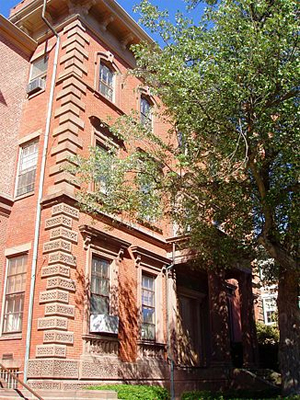
John Tucker Daland House
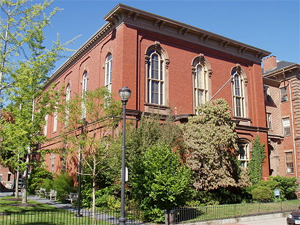
Plummer Hall (formerly Salem Athenaeum)
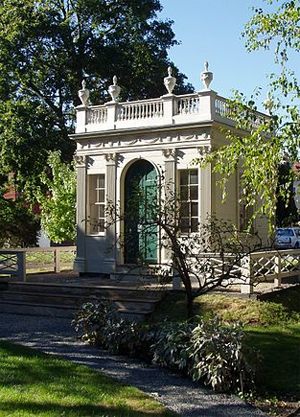
Derby-Beebe Summer House
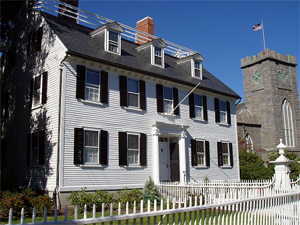
Ropes Mansion
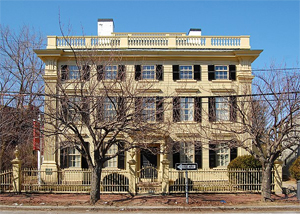
Peirce-Nichols House
American art
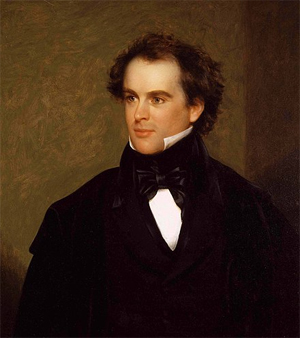
Nathaniel Hawthorne by Charles Osgood
Among the American artists represented in the museum's collection:
• Clifford Warren Ashley[52]
• James Bard[52]
• Frank Weston Benson[53]
• John Prentiss Benson
• James E. Buttersworth[52]
• John Singleton Copley[53]
• Michele Felice Cornè[52]
• George Washington Felt (1776–1847)[53]
• Alvan Fisher[53]
• Fitz Hugh Lane[52]
• Charles Osgood[53]
• Frederic Remington[53]
• George Ropes, Jr. (1788–1819)[53]
• Robert Salmon[52]
• John Singer Sargent[53]
• William Pierce Stubbs
• Charles Wilkes[52]
See also
• Huangshan District
• Essex Institute Historic District
References
1. PEM website. "Museum history." Retrieved 2011-02-16
2. The manual of museum exhibitions by Gail Dexter Lord (Rowman Altamira, 2002) https://books.google.com/books?id=dTKb1 ... navlinks_s
3. [1] Archived February 2, 2008, at the Wayback Machine
4. https://www.bostonmagazine.com/arts-ent ... admission/
5. Peabody Essex Museum collections (Peabody Essex Museum, 1999)
6. https://www.wsj.com/articles/SB10001424 ... 3690093908
7. Peabody Essex announces $650 million campaign, WickedLocal.com, November 14, 2011
8. Peabody Essex vaults into top tier by raising $550 million Archived 2012-07-09 at the Wayback Machine, Boston Globe, November 6, 2011.
9. PEM announces $650 million advancement Archived 2013-01-26 at the Wayback Machine, Peabody Essex Museum press release, November 7, 2011.
10. https://www.boston.com/yourtown/news/sa ... pares.html
11. McGreevy, Nora (July 12, 2019). "Peabody Essex Museum expansion to open in September". The Boston Globe. Retrieved 2019-08-08.
12. http://www.architectsjournal.co.uk/news ... 23.article
13. Lorch, Danna (July 1, 2019). "The Peabody Essex Museum Prepares to Unveil a Thoughtfully Designed 40,000-square-foot Expansion". Architectural Digest. Retrieved 2019-09-28.
14. https://www.architecturaldigest.com/sto ... -expansion
15. Whyte, Murray (March 7, 2019). "Peabody Essex Museum names its new director". The Boston Globe. Retrieved 2019-08-08.
16. Dobrzynski, Judith H. (Jan 28, 2013). "A New Way Forward". The Wall Street Journal. Retrieved 31 July 2013.
17. "PEM names Brian Kennedy as Director and CEO". Peabody Essex Museum. Retrieved 2019-08-08.
18. Shea, Andrea (March 7, 2019). "Brian Kennedy Named The Peabody Essex Museum's New Director And CEO". WBUR. Retrieved 2019-08-08.
19. Whyte, Murray (March 7, 2019). "Peabody Essex Museum names its new director". The Boston Globe. Retrieved 2019-08-08.
20. "Current Status of Collection Documentation," Peabody Essex Museum Curatorial Department, March 25, 2014
21. https://www.pem.org/index.php?p=explore-art/african-art Retrieved 2015-07-13
22. Grimes, John R. (1984). "The Tribal Style: Selections from the African Collection at the Peabody Museum of Salem."
23. https://www.pem.org/index.php?p=explore ... erican-art Retrieved 2015-07-13
24. Whitehall, Walter M. (1949). "The East India Marine Society and the Peabody Museum of Salem: A Sesquicentennial History."
25. "Current Status of Collection Documentation," Peabody Essex Museum Curatorial Department, March 25, 2014
26. https://www.pem.org/index.php?p=explore-art/chinese-art Retrieved 2015-07-13
27. Johnston, Patricia (2012). "Global Knowledge in the Early Republic: The East India Marine Society's 'Curiosities' Museum."
28. Rozhon, Tracy. "Moving House, With 2,000 Chinese Parts." The New York Times, February 6, 2001.
29. "Current Status of Collection Documentation," Peabody Essex Museum Curatorial Department, March 25, 2014
30. https://www.pem.org/index.php?p=explore-art/indian-art Retrieved 2015-07-20
31. SACHI: the Society for Art & Cultural Heritage of India. http://sachi.org/event%20PDFs/SACHI_June_050113.pdf Retrieved 2015-07-20.
32. Bean, Susan S. (2006). Arts of Asia Vol. 36, No.3
33. "Current Status of Collection Documentation," Peabody Essex Museum Curatorial Department, March 25, 2014
34. https://www.pem.org/index.php?p=explore ... panese-art Retrieved 2015-07-20.
35. Oka, Midori (2006). Arts of Asia Vol. 36, No.3
36. The Peabody Essex Museum, "A Teacher's Sourcebook for Korean Art & Culture." https://www.pem.org/index.php?p=aux/pdf ... ea-tsb.pdf
37. https://www.pem.org/index.php?p=explore-art/korean-art Retrieved 2015-07-13
38. Bean, Susan S. (2006). Arts of Asia Vol. 36, No.3
39. "Salem's International Trade". National Park Service, Department of the Interior. https://www.nps.gov/sama/learn/historyculture/trade.htm Retrieved 2015-07-20.
40. https://www.pem.org/index.php?p=explore ... nd-history Retrieved 2015-07-20.
41. Finamore, Daniel (2002). "The Peabody Essex Museum and the Sea." Antiques and Fine Arts Magazine. Retrieved 2015-07-20.
42. "Current Status of Collection Documentation," Peabody Essex Museum Curatorial Department, March 25, 2014
43. https://www.pem.org/index.php?p=explore ... erican-art Retrieved 2015-07-20.
44. The Peabody Essex Museum (1997). Gifts of the Spirit: Works by Nineteenth-Century & Contemporary Native American Artists.
45. "Current Status of Collection Documentation," Peabody Essex Museum Curatorial Department, March 25, 2014
46. http://www.pem.org/sites/archives/asian2.htm. Retrieved 2015-07-20.
47. Peabody Museum of Salem (1920). The Hawaiian Portion of the Polynesian Collections in the Peabody Museum of Salem.
48. "Current Status of Collection Documentation," Peabody Essex Museum Curatorial Department, March 25, 2014
49. https://www.pem.org/index.php?p=explore-art/photography Retrieved 2015-07-20.
50. Mariner's Museum and Peluso, Anthony J., Jr., The Bard Brothers – Painting America under Steam and Sail, Abrams, New York 1997 ISBN 0-8109-1240-6
51. "Statement Regarding PEM Phillips Library". Peabody Essex Museum. Retrieved 2017-12-09.
52. Peabody Essex Museum. Maritime Art and History. Retrieved 2011-12-07
53. Peabody Essex Museum. American Art. Retrieved 2011-12-07
Further reading
• Christina Hellmich Scarangello (1996). "Pacific Collection in the Peabody Essex Museum, Salem, Massachusetts". Pacific Arts (13/14). JSTOR 23409781.
• Re-enactment and the Museum Case: Reading the Oceanic and Native American Displays in the Peabody Essex Museum. Anna Boswell. Journal of New Zealand Literature, No. 27 (2009). JSTOR 25663046.
• Traute M. Marshall (2009). "Peabody Essex Museum". Art Museums Plus: Cultural Excursions in New England. University Press of New England. ISBN 978-1-58465-621-0.
External links
• Official website
by Wikipedia
Accessed: 6/25/20
Early museums both represented and obscured the Massachusetts colony's links to Europe, Africa, and Asia; early institutions such as the East India Marine Society (founded in Salem in 1799) preserved goods and specimens collected by prominent members of the early settler mariner colony, while museums established later in the nineteenth or twentieth centuries, such as the Peabody Essex or the Museum of Fine Arts (founded 1870) mark the place of Boston within imperial global connections and interdependencies.31 Museums, like colonial archives, are not static repositories or records. James Clifford, borrowing of Mary Louise Pratt's concept, suggests that museums are "contact zones," or spaces of encounter, exchange, and conflict. In the museum, an asymmetrical relationship between the collector and the collected, the viewer and the viewed is at work; objects are taken out of time and history, placed in glass cases, and staged to be viewed within a tableau of new meanings.32 Museums naturalize the authority of the sponsoring culture through normative standards of classification, selection, and display, and they solicit the public as viewers of the objects collected. In this sense, museums are a material pedagogy that positions not only subject and object, but also defines the past and present, the living and the dead. They are, as Svetlana Alpers famously put it, "a way of seeing." Ivan Karp observed that within the conditions of increasing pluralism of multicultural and global perspectives, contemporary museum display practices now seek teh perspectives of living communities with stakes or knowledge in their exhibits, yet curatorial decisions may often continue to reflect institutional judgments defining what the nation or culture is or ought to be, as well as who may claim citizenship or belonging in that nation.33 It is in this way that historian Jean O'Brien observes that local historical museums of Massachusetts, Rhode Island, or Connecticut often represent the English settlers as both "first and last," both preceding native people, and surviving their demise. Even when new forms of museum practice, display, and consultation aim for respectful inclusion and seek to give voice to contemporary indigenous peoples, they can often reiterate the common myth that Native Americans have vanished, and render them historically past, rather than representing the complex history through which policies created incremental dispossession and forcible assimilation.
The membership of the East India Maritime Society, forerunner of the Peabody Essex Museum that stands in Salem today, was originally composed of shipmasters and mariners who had traveled around both the Cape of Good Hope and Cape Horn (The East-India Marine Society 3). The Society's first printed catalogue in 1821 emphasized that its collection "of natural and artificial curiosities" would serve as the patrimony for successive American generations; a motto of the Society that often served as a toast at Society Dinners was: "A Cabinet. That every mariner may possess the history of the world." The "curiosities" collected by the settler-mariners included archeological objects, natural specimens, and art objects, conflating native peoples and cultures with natural minerals and plants, and blurring the provenance of objects from India, China, Tahiti, Hawaii or Turkey, with those of Native American tribes or indigenous Hawaiian peoples. The 1821 Catalogue of Articles records ships' voyages, such as "No. 27. Ship Fame, Jeremiah Briggs master, from Salem to Cochin China, Manilla and back, 1803-1804" or "No. 43. Ship Derby, Thomas West master, from Boston to Naples, Canton, and back, 1805- 1806" (The East-India Marine Society 25, 27). It also lists a bewildering variety of collected objects, including weapons, shoes, cloths, clothing, ornamental jewelry, tools, etc. as well as mineral specimens, stones, birds, snakes, fish, shells, coins, insects (from China, Egypt, South America, as well as North America, etc.). Like the British East India Company, the Salem East India Maritime Society was part of an early phase of globalization as mercantilism shifted from company monopolies to liberal free trade, from long-term contracted agreements to lucrative new markets, from territorial conquest to liberal governance, and from slavery to abolition. In the late nineteenth century, the East India Marine Society combined with the Peabody Academy of Science, and then in the late twentieth century, it joined the Essex Institute to become the Peabody Essex Museum, bringing together the collections associated with marine voyages, natural history, and ethnology. In museum historian Walter Whitehill's words, the Peabody Essex "thus still fulfilled both the purpose of the East India Marine Society to collect 'natural and artificial curiosities' and the object of George Peabody's trust to promote science and useful knowledge" (131). Today, the Peabody Essex features a distinguished collection of Native American art, China export trade goods, and Australasian and Pacific Islander souvenirs, staged to give visitors a sense of an earlier social Zeitgeist, to replicate what the early museum may have looked like.34 Wood carved figureheads from ships' prows adorn the walls lined with cabinets that assemble items of disparate and distant origins: an Incan figure, a Tahitian mask, a Lakotan pipe bowl, and a Calcutta likeness of Jagannatha share a shelf with an early American voting box. Furthermore, the museum has steadily acquired Asian decorative arts, and now possesses the largest collection of Chinese export goods in the United States.
Like the British East India Company, the Salem East-India Maritime Society was part of an early phase of globalization as mercantilism shifted away from monopolies of Companies to liberal free trade, from long-term contracted agreements to lucrative new markets, new trade routes, from colonialism to liberal governance, from slavery to abolition. The museum had a clear relationship to the emerging nation; its motto "First in the United States" for "descendants, in some distant day" represents its mission of collecting and constituting a nationalist legacy to be passed on from American settler-mariner fathers to citizen-sons. The symbolic capital of traditional and new elites was acquired through newly invented divisions of "highbrow" and "lowbrow" cultures and objects, through inventing tradition and "heritage" for the "public" and becoming a state pedagogy and a resource for tourism. As a changing, situated cultural institution, the museum tells the "self-fashioned providential story," in Jean O'Brien's words (xii), of the emergence of a national state and its specific engagements with local commerce, as well as its ultimate transformations in relation to globalization. Even when the museum is commemorative, historical, or educational, it is never wholly separate from these commercial forces.
-- Harbors, Flows, and Migrations: The USA in/and the World, edited by Anna De Biasio, Gianna Fusco, Serena Fusco and Donatella Izzo

Peabody Essex Museum
The main entrance to the museum
Peabody Essex Museum is located in MassachusettsPeabody Essex Museum
Established: 1799
Location: 161 Essex Street, Salem, MA 01970
Type: Art museum
Accreditation: AAM, NARM
Director: Brian Kennedy
Public transit access: Newburyport/Rockport Line; Salem Station Handicapped/disabled access
Website pem.org
The Peabody Essex Museum (PEM) in Salem, Massachusetts, US, is a successor to the East India Marine Society, established in 1799.[1] It combines the collections of the former Peabody Museum of Salem (which acquired the Society's collection) and the Essex Institute.[2][3] PEM is the oldest continuously operating museum in the United States [4] and holds one of the major collections of Asian art in the United States. Its total holdings include about 1.3 million pieces, as well as twenty-two historic buildings.[5]
The Peabody Essex ranks among the top 20 art museums in the United States by measures including gallery space and endowment. Once the Advancement Campaign is complete and the newly expanded museum opens in 2019, PEM will rank in the top 10 North American art museums in terms of gallery square footage, operating budget and endowment. The PEM holds more than 840,000 works of historical and cultural art covering maritime, American, Asian, Oceanic and African art, Asian export art and two large libraries with over 400,000 books and manuscripts.[6]
History
In 1992, the Peabody Museum of Salem merged with the Essex Institute to form the Peabody Essex Museum.[5] Included in the merger was the legacy of the East India Marine Society, established in 1799 by a group of Salem-based captains and supercargoes. Members of the Society were required by the society's charter to collect "natural and artificial curiosities" from beyond the Cape of Good Hope or Cape Horn. They were also required to personally circumnavigate the globe, and share navigational discoveries with other Society members, thereby increasing their chances of returning from their voyages safely. Due to the institution's age, the items they donated to the collections are significant for their rare combination of age and provenance. The East India Marine Society built East India Marine Hall, a National Historic Landmark now embedded in the museum's facilities, in the 1820s to house its collection. This collection was acquired by the Peabody Academy of Science (later renamed the Peabody Museum of Salem) in 1867, along with the building, which continued to serve as a museum space through these mergers and acquisitions.

George Peabody, benefactor
2000s–2010s

The East India Marine Hall is one of the oldest parts of the museum, built in 1825. The space is used for special events, and for temporary art installations
In 2003, the museum completed a massive $100 million renovation and expansion resulting in the Peabody Essex Museum opening a new wing designed by Moshe Safdie, more than doubling the gallery space to 250,000 square feet (23,000 m²); this allowed the display of many items from its extensive holdings, which had previously been unknown to the public due to lack of exhibition space. At this time, the museum also opened to the public the Yin Yu Tang House, an early 19th-century Chinese house from Anhui Province that had been disassembled in its original village and reconstructed in Salem.[5]
In 2011, the Peabody Essex Museum announced it had raised $550 million, with plans to raise an additional $100 million by 2016.[7] The Boston Globe reported this was the largest capital campaign in the museum's history, vaulting the Peabody Essex into the top tier of major art museums.[8] The PEM trustee co-chairs Sam Byrne and Sean Healey with board president Robert Shapiro led the campaign.[9]$200 to $250 million will fund the museum’s 175,000-square-foot (16,300 m2) expansion bringing the total square footage to 425,000 square feet (39,500 m2).[10]
In May 2012, the PEM confirmed that its expansion will not be finished until 2019, due to the unexpected death of museum architect Rick Mather in April 2012 and the search for his replacement. The firm of Ennead Architects was chosen after successfully completing the first phase of the building project, which included master planning and the renovation of the museum's Dodge wing, scheduled to open in November 2013. [11][12]
On September 28, 2019 the museum opened a new 40,000-square-foot wing, designed by Ennead Architects of New York, adjacent to East India Marine Hall. This addition included 15,000 square feet of Class A galleries as well as a 5,000-square-foot-garden designed by Nelson Byrd Woltz Landscape Architects. [13][14]
Leadership
The museum was led by Dan Monroe, the Rose-Marie and Eijk van Otterloo Director and CEO from 1993 until his retirement in 2019.[15][16] He was succeeded on July 15, 2019 by Brian Kennedy, who previously directed the Toledo Museum of Art.[17][18] Kennedy has served as assistant director of the National Gallery of Ireland, director of the National Gallery of Australia, and director of the Hood Museum of Art at Dartmouth College. Kennedy has an abiding interest in perception and visual literacy and is deeply committed to arts education. [19]

Peabody Museum of Salem origins
Collections
African Art
The Peabody Essex Museum's collection of African art includes approximately 3,600 objects as of 2014. [20] The acquisition of these works began in the early 19th century, as members of the East India Marine Society collected objects from West and sub-Saharan Africa. These objects include ceremonial masks, pottery, woven baskets, and a significant collection of Ethiopian art—particularly Christian icons and metalwork, many of which are based in the traditions of Byzantine art.[21] In 1812, Salem became the headquarters of the American Board of Commissioners for Foreign Missions, which went on to establish missions throughout the continent. These missions facilitated trade, particularly with the Zulu in South Africa, and contributed significantly to the growth of the collection.[22]
American Art
PEM's extensive collection of American art includes over 1,000 portraits,[23] among them works by John Singer Sargent, Fitz Henry Lane, and James Bard. Furniture, folk art, and needlework are also prominent features of the collection. The museum's New England heritage has brought it an especially large array of decorative arts from the Northeastern United States. Many of these objects were initially collected by the Essex Institute, which was dedicated to preserving the cultural and physical history of Essex County.[24]
Chinese Art
The museum's collection of Chinese art, which includes over 6,000 objects[25], features contemporary and ancient works as well as works by minority nationalities within China.[26] Ceramics, textiles, and calligraphy form the bulk of the collection, which began in the 18th century with exports acquired by New England traders. Even before the founding of the East India Marine Society, missionaries such as Reverend William Bentley were collecting sculptures, fans, and other pieces that would form the foundation of the museum's collection.[27] The largest piece at the museum is the Yin Yu Tang House, a late 18th century home from the Anhui province of China. This house, constructed during the Qing Dynasty, was acquired by Nancy Berliner, at the time PEM's curator of Chinese art and culture, before being taken apart and reassembled in Salem.[28]
Indian Art
The Peabody Essex Museum's collection of Indian art includes over 5,000 objects.[29] It also possesses numerous works of Tibetan and Nepalese origins, along with perhaps the most important collection of contemporary Indian art outside of India.[30] PEM's Herwitz Gallery, opened in 2003 and named to honor art collectors Chester and Davida Herwitz, is the first American museum gallery dedicated to modern Indian art.[31] PEM's collection spans a wide array of eras and mediums, forming a detailed record of India's artistic transformations during colonial rule and its aftermath. As PEM's ex-curator of South Asia and Korean Art Susan S. Bean observed, "the global development of industrial production brought machine-woven textiles, printed images, and photography into competition with handlooms, sculpture, and painting," all of which are art forms well represented throughout PEM's collection.[32]
Japanese Art
Featuring approximately 18,300 objects,[33] PEM's collection of Japanese art began with the museum's inception in 1799. Its collections of work from the Edo Period and Meiji Period are particularly robust, featuring armor, sculpture, painted scrolls, furniture, and more.[34] Much of the collection has its origins in the travels of Edward S. Morse, the third director of the museum, who acquired many pieces over the course of three trips to Japan. Morse also helped raise interest in Japanese art in Massachusetts and New England: as Midori Oka states, Morse was "instrumental in influencing the area intellectuals and connoisseurs to turn their interests to Japanese art."[35]
Korean Art
The Peabody Essex Museum has approximately 1,800 pieces of Korean art in its collection, including ceramics, textiles, and painted screens. The collection began in 1883, as the result of a collaboration between museum director Edward Sylvester Morse and Korean scholar Yu Kil-chun, who was a member of the first official Korean delegation to the United States.[36] Much of the collection consists of art of the Joseon Dynasty, which occupied the transitional period between the traditional Korean empire and modernity.[37] Many of the pieces in the collection, particularly those from the Joseon period, display the centrality of art in the habits, rituals, and ceremonies of everyday Korean life. As former PEM curator Susan S. Bean observes, art objects were "essential to the conduct of social life because they conveyed values, fulfilled wishes, provided access to deities and ancestors, taught lessons and conferred prestige."[38]
Maritime Art
By the end of the 18th century, coinciding with the museum's 1799 founding, Salem was one of the nation's most prosperous seaports, and extensive trading of furs, spices, dyes, and other goods brought much wealth to the region.[39] This long legacy of trade contributed greatly to the foundation and growth of PEM's maritime art collection, which is among the finest of its kind in the country.[40] The collection includes over 50,000 objects, including paintings, model ships, scrimshaw, and more. Many diverse styles and periods of maritime art are on display in the collection, from navigational tools such as sextants to modern marine art, which addresses "nostalgic themes" and represents "the seafaring life of previous times."[41] One significant feature of the currently installed collection is a recreation of a room in Cleopatra's Barge, an opulent yacht which was built by Salem's Crowninshield family and eventually became the royal yacht of King Kamehameha II.
Native American Art
PEM's collection of Native American art includes over 20,000 objects,[42] spanning a wide variety of tribal affiliations and time periods. The collection includes masks, textiles, jewelry, clothing, sculpture, and more, along with many pieces by contemporary Native American artists such as Frank Day and Kay WalkingStick.[43] The origins of PEM's collection can be traced to even before the museum's 1799 founding: the maritime fur trade, as well as the trading of iron to local tribes, made the exchange of art objects a frequent occurrence. As Richard Conn writes, "in some cases, objects of considerable importance were given by their native owners as gifts to their European trading partners. The intent here was probably to enhance the trading relationship and to insure that the Yankee or British ship would return next year with more iron."[44]
Oceanic Art
Featuring objects from over 36 different groups of islands in Polynesia, Melanesia, and Micronesia, the Peabody Essex Museum's collection of Oceanic art contains over 15,000 objects in total.[45] These objects, consisting of sculptures, weapons, clothing, and more, include pieces made from traditional Oceanic materials such as porpoise teeth, abalone, and human hair. Also worth noting is the museum's particularly substantial collection of Hawaiian art, which includes over 5,000 objects.[46] While Salem had little direct trade with Hawaii during the 18th and 19th centuries, regional trade and donations from prominent sea captains led to the acquisition of many significant pieces, including some associated with Kamehameha I and James Cook.[47]
Photography
PEM's collection of photography is its largest single collection by number of objects, featuring over 850,000 images.[48] The collection began in 1840, just one year after the invention of photography. It includes work by pioneering photographers such as William Henry Fox Talbot and Antoine Claudet. It also features a collection of rare Civil War photographs by Matthew Brady, one of the first American photographers. The collection has a vast variety of subjects and styles, from records of native life in the Philippines to photographs by Walker Evans which document the Great Depression.[49]

The spacious central atrium has movable solar shades – (July 2013)
The museum presently owns collections of maritime art, including works by marine artist James Bard.[50] The museum also has collections of rare books, manuscripts and ephemera (in the Phillips Library); photography (a collection comprising more than a half million rare and vintage images). On December 8, 2017, much to the dismay of Salem residents, Dan L. Monroe, PEM’s Rose-Marie and Eijk van Otterloo Director and CEO, issued a press release announcing that the 42,000 linear feet of historical documents will be permanently relocated to Rowley, Massachusetts and Plummer Hall and Daland House, the two historic buildings which had housed the Phillips Library, will be utilized as office and meeting space.[51]
Architecture in the collection
The museum owns 24 historic structures and gardens, some of which are concentrated in the old Essex Institute grounds which now form the Essex Institute Historic District. 5 of these buildings are National Historic Landmarks and 8 others are listed on the National Register of Historic Places. Some are shown in the gallery below. The full set of buildings are: Daniel Bray House, Gilbert Chadwick House, Cotting-Smith Assembly House, Crowninshield-Bentley House, John Tucker Daland House, Derby-Beebe Summer House, East India Marine Hall (integrated into the main museum), Gardner-Pingree House and Gardner-Pingree Carriage House, Lyle-Tapley Shoe Shop, Dodge Wing of the Peabody Essex Museum, Asian Export Art Wing of the Peabody Essex Museum, Peirce-Nichols House, Samuel Pickman House, Plummer Hall, Quaker Meeting House, L. H. Rogers Building, Ropes Mansion, Andrew Safford House, Summer School Building, Vilate Young (Kinsman) House, and John Ward House.[5] Some of these properties are open to guided tours.

John Tucker Daland House

Plummer Hall (formerly Salem Athenaeum)

Derby-Beebe Summer House

Ropes Mansion

Peirce-Nichols House
American art

Nathaniel Hawthorne by Charles Osgood
Among the American artists represented in the museum's collection:
• Clifford Warren Ashley[52]
• James Bard[52]
• Frank Weston Benson[53]
• John Prentiss Benson
• James E. Buttersworth[52]
• John Singleton Copley[53]
• Michele Felice Cornè[52]
• George Washington Felt (1776–1847)[53]
• Alvan Fisher[53]
• Fitz Hugh Lane[52]
• Charles Osgood[53]
• Frederic Remington[53]
• George Ropes, Jr. (1788–1819)[53]
• Robert Salmon[52]
• John Singer Sargent[53]
• William Pierce Stubbs
• Charles Wilkes[52]
See also
• Huangshan District
• Essex Institute Historic District
References
1. PEM website. "Museum history." Retrieved 2011-02-16
2. The manual of museum exhibitions by Gail Dexter Lord (Rowman Altamira, 2002) https://books.google.com/books?id=dTKb1 ... navlinks_s
3. [1] Archived February 2, 2008, at the Wayback Machine
4. https://www.bostonmagazine.com/arts-ent ... admission/
5. Peabody Essex Museum collections (Peabody Essex Museum, 1999)
6. https://www.wsj.com/articles/SB10001424 ... 3690093908
7. Peabody Essex announces $650 million campaign, WickedLocal.com, November 14, 2011
8. Peabody Essex vaults into top tier by raising $550 million Archived 2012-07-09 at the Wayback Machine, Boston Globe, November 6, 2011.
9. PEM announces $650 million advancement Archived 2013-01-26 at the Wayback Machine, Peabody Essex Museum press release, November 7, 2011.
10. https://www.boston.com/yourtown/news/sa ... pares.html
11. McGreevy, Nora (July 12, 2019). "Peabody Essex Museum expansion to open in September". The Boston Globe. Retrieved 2019-08-08.
12. http://www.architectsjournal.co.uk/news ... 23.article
13. Lorch, Danna (July 1, 2019). "The Peabody Essex Museum Prepares to Unveil a Thoughtfully Designed 40,000-square-foot Expansion". Architectural Digest. Retrieved 2019-09-28.
14. https://www.architecturaldigest.com/sto ... -expansion
15. Whyte, Murray (March 7, 2019). "Peabody Essex Museum names its new director". The Boston Globe. Retrieved 2019-08-08.
16. Dobrzynski, Judith H. (Jan 28, 2013). "A New Way Forward". The Wall Street Journal. Retrieved 31 July 2013.
17. "PEM names Brian Kennedy as Director and CEO". Peabody Essex Museum. Retrieved 2019-08-08.
18. Shea, Andrea (March 7, 2019). "Brian Kennedy Named The Peabody Essex Museum's New Director And CEO". WBUR. Retrieved 2019-08-08.
19. Whyte, Murray (March 7, 2019). "Peabody Essex Museum names its new director". The Boston Globe. Retrieved 2019-08-08.
20. "Current Status of Collection Documentation," Peabody Essex Museum Curatorial Department, March 25, 2014
21. https://www.pem.org/index.php?p=explore-art/african-art Retrieved 2015-07-13
22. Grimes, John R. (1984). "The Tribal Style: Selections from the African Collection at the Peabody Museum of Salem."
23. https://www.pem.org/index.php?p=explore ... erican-art Retrieved 2015-07-13
24. Whitehall, Walter M. (1949). "The East India Marine Society and the Peabody Museum of Salem: A Sesquicentennial History."
25. "Current Status of Collection Documentation," Peabody Essex Museum Curatorial Department, March 25, 2014
26. https://www.pem.org/index.php?p=explore-art/chinese-art Retrieved 2015-07-13
27. Johnston, Patricia (2012). "Global Knowledge in the Early Republic: The East India Marine Society's 'Curiosities' Museum."
28. Rozhon, Tracy. "Moving House, With 2,000 Chinese Parts." The New York Times, February 6, 2001.
29. "Current Status of Collection Documentation," Peabody Essex Museum Curatorial Department, March 25, 2014
30. https://www.pem.org/index.php?p=explore-art/indian-art Retrieved 2015-07-20
31. SACHI: the Society for Art & Cultural Heritage of India. http://sachi.org/event%20PDFs/SACHI_June_050113.pdf Retrieved 2015-07-20.
32. Bean, Susan S. (2006). Arts of Asia Vol. 36, No.3
33. "Current Status of Collection Documentation," Peabody Essex Museum Curatorial Department, March 25, 2014
34. https://www.pem.org/index.php?p=explore ... panese-art Retrieved 2015-07-20.
35. Oka, Midori (2006). Arts of Asia Vol. 36, No.3
36. The Peabody Essex Museum, "A Teacher's Sourcebook for Korean Art & Culture." https://www.pem.org/index.php?p=aux/pdf ... ea-tsb.pdf
37. https://www.pem.org/index.php?p=explore-art/korean-art Retrieved 2015-07-13
38. Bean, Susan S. (2006). Arts of Asia Vol. 36, No.3
39. "Salem's International Trade". National Park Service, Department of the Interior. https://www.nps.gov/sama/learn/historyculture/trade.htm Retrieved 2015-07-20.
40. https://www.pem.org/index.php?p=explore ... nd-history Retrieved 2015-07-20.
41. Finamore, Daniel (2002). "The Peabody Essex Museum and the Sea." Antiques and Fine Arts Magazine. Retrieved 2015-07-20.
42. "Current Status of Collection Documentation," Peabody Essex Museum Curatorial Department, March 25, 2014
43. https://www.pem.org/index.php?p=explore ... erican-art Retrieved 2015-07-20.
44. The Peabody Essex Museum (1997). Gifts of the Spirit: Works by Nineteenth-Century & Contemporary Native American Artists.
45. "Current Status of Collection Documentation," Peabody Essex Museum Curatorial Department, March 25, 2014
46. http://www.pem.org/sites/archives/asian2.htm. Retrieved 2015-07-20.
47. Peabody Museum of Salem (1920). The Hawaiian Portion of the Polynesian Collections in the Peabody Museum of Salem.
48. "Current Status of Collection Documentation," Peabody Essex Museum Curatorial Department, March 25, 2014
49. https://www.pem.org/index.php?p=explore-art/photography Retrieved 2015-07-20.
50. Mariner's Museum and Peluso, Anthony J., Jr., The Bard Brothers – Painting America under Steam and Sail, Abrams, New York 1997 ISBN 0-8109-1240-6
51. "Statement Regarding PEM Phillips Library". Peabody Essex Museum. Retrieved 2017-12-09.
52. Peabody Essex Museum. Maritime Art and History. Retrieved 2011-12-07
53. Peabody Essex Museum. American Art. Retrieved 2011-12-07
Further reading
• Christina Hellmich Scarangello (1996). "Pacific Collection in the Peabody Essex Museum, Salem, Massachusetts". Pacific Arts (13/14). JSTOR 23409781.
• Re-enactment and the Museum Case: Reading the Oceanic and Native American Displays in the Peabody Essex Museum. Anna Boswell. Journal of New Zealand Literature, No. 27 (2009). JSTOR 25663046.
• Traute M. Marshall (2009). "Peabody Essex Museum". Art Museums Plus: Cultural Excursions in New England. University Press of New England. ISBN 978-1-58465-621-0.
External links
• Official website
